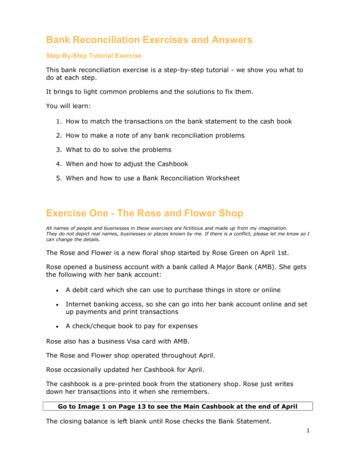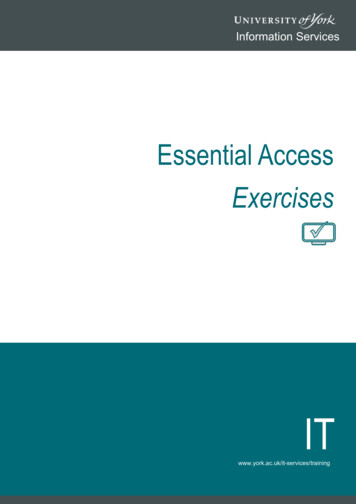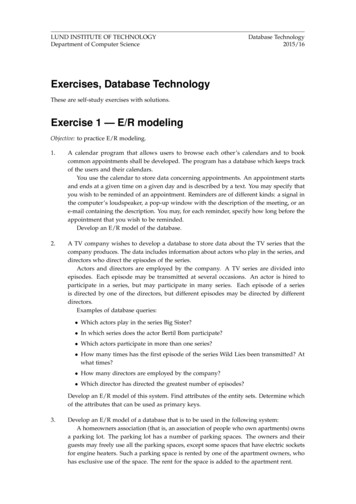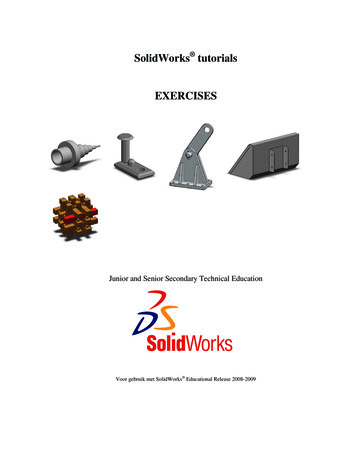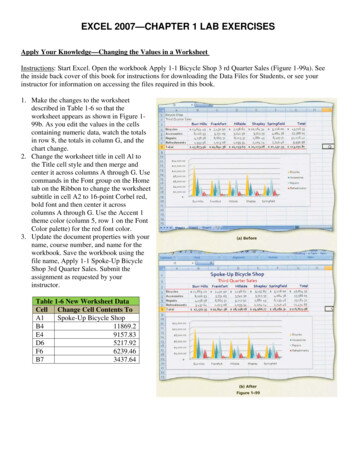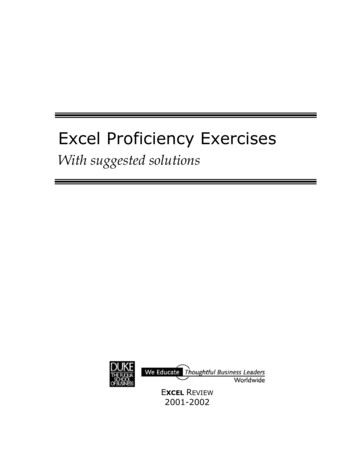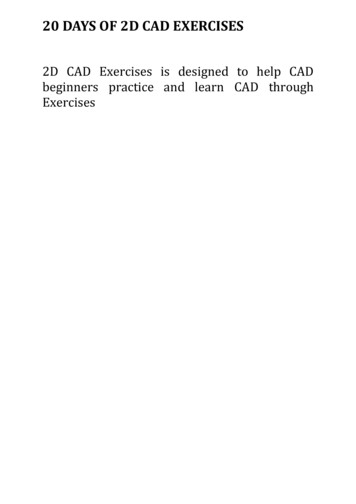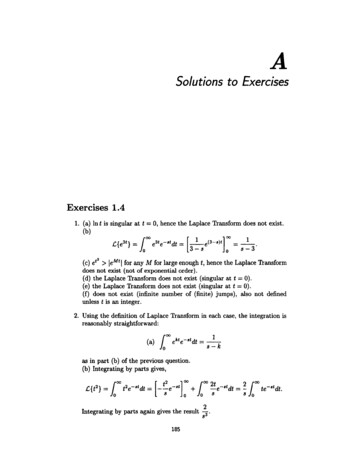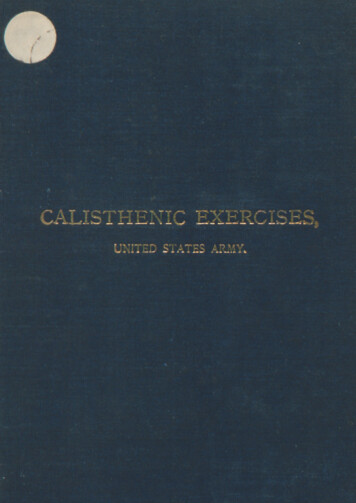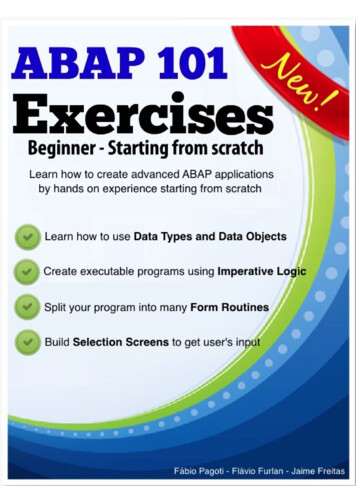
Transcription
ABAP 101 Exercises - BeginnerStarting from scratchLearn how to create advanced ABAP applicationsby hands on experience starting from scratch Learn how to use Data Types and Data ObjectsCreate executable programs using Imperative LogicSplit your program into many Form RoutinesBuild Selection Screens to get user's inputFreitas – Furlan – Pagoti
Jaime Freitas, Flávio Furlan and Fábio PagotiABAP 101 Exercises - Beginner - Starting from scratch
Notes on UsageABAP 101 Exercises - Beginner - Starting from scratch by Jaime Freitas, Flávio Furlan and FábioPagoti is licensed under a Creative Commons Attribution-NonCommercial-NoDerivatives 4.0International License.Based on a work at http://abap101.com/ebook
ContentsNotes on Usage.5Foreword by Fábio Pagoti. 7Foreword by Flávio Furlan. 8Foreword by Jaime Freitas. 9Introduction. 10Where is the theory?. 10Are 101 exercises enough?. 10What you should have/know before starting the exercises. 11Answers.11Exercises guidelines.11General Instructions. 11Part I - Data Types and Objects (1 - 40). 12Part II - Imperative Logic (41 - 72). 53Part III – Selection Screens (73 – 101).108Appendices. 139Publishing your answers on the Internet.140The Authors.141
Foreword by Fábio PagotiI read many technical books. Most of them are related with programming and not always ABAP.Usually the authors dedicate their books to their wife and kids. It seems like in order to become anauthor you must become a husband and a father beforehand.So you might say I took the wrong direction somewhere as I'm writing my first book without evenbeing engaged. Well, definitely if it weren't my parents I would never have written this book so Ithank them on the first place.Nevertheless, I do have other people to thank. First and most important, Flávio Furlan, a formerwork colleague and a permanent friend. We idealized this book long ago and after manyconversations (some on Skype during almost the whole dawn) we could see a good progress.Firstly this book would be written in Portuguese, as it's our native language and due to the lack ofgood SAP learning resources on such language. But we would rather reach as many people aspossible writing it in English and making it free of charge (or at least asking you to pay with asingle Tweet or Share on Facebook or LinkedIn).I also must thank Jaime, who was one of my best ABAP students as he kept studying even after hiscourse had finished. He patiently was the very first person to complete all 101 exercises. Moreover,he did a great job reviewing each question and giving awesome hints on how to make each questionshorter and clearer.Last but not least I thank you for reading these words and for having no shame on start somethingfrom scratch. I really hope this book can be your first steps on a great professional experience as anABAP developer.Fábio PagotiABAP Consultant and Trainer @ Ka Solution
Foreword by Flávio FurlanI taught ABAP for more than 5 years. Our training was based on four weeks of theory and simpleexercises and one more week when students were requested to solve more difficult exercises. Afterall those years, I can assure to say that our students learn the basics on theory-exercise weeks andstart to master in the last week, doing exercises by themselves.You can read the help about WRITE, CONCATENATE and SELECT, but you will only learn whenyou use it. That is the spirit of this book! Practice, practice and practice!When I was studying for college admission, my brother, a former ITA engineer (AeronauticsInstitute of Technology in English, one of the most difficult college admissions in Brazil) used toshow me several completed exercise books. 100% completed! Exercise by exercise. Step by step.That is what successful professionals have in common: hard work.What you have in your hands looks silly in the beginning, but it gets more difficult and someexercises could represents truly challenges. Do not give up! If you are a beginner ABAPer do afavor to yourself, start from the exercise one and go further until the last one. It worth the effort!Our first idea was just to present the exercises, but thanks to Fábio Pagoti and Jaime Freitas you canalso count with solutions. Remember: it’s not a crosswords book. There is no proud to complete itchecking the answers. Don’t lose your time checking the answers before actually solve (see that Ididn’t said try). Consider the words from Yoda Master for each exercise “Try not. Do. or do not.There is no try”.When you finish the last one, please generate a ZIP file with all solutions and e-mail me withsubject “Take it, Furlan!”. I dare you!I really hope you enjoy and learn a lot with that book!I also like to thank Fábio and Jaime! They really did a hard work to finish that! Thank you guys!Flávio FurlanTechnical Architect @ Nestlé
Foreword by Jaime FreitasThe ebook “ABAP 101 Exercises - Beginner - Starting from scratch” is more than an extra learningresource for ABAP freshmen. It's also a reusable guide and an opportunity to review manytechniques which are used on a daily basis during the development of Z programs or whenenhancing standard SAP Programs.Without a shadow of a doubt, no matter if you are just starting or if you have been working forsome time with ABAP, this ebook deserves your attention.Here, you will find the application of many concepts in an objective and dynamic way. Thisconcepts can be consulted or deepened by you later so you can address day-to-day doubts relatedwith a specific ABAP command, its use and variations.I had access to this learning resource during its development phase when I had just finished anABAP course. Particularly, it was very useful for reviewing concepts which I learned during thecourse. I truly believe this material will be useful in your daily job, being a young learner like me orsomeone already inside on SAP world.Jaime FreitasSenior System Analysis @ Lojas Riachuelo
IntroductionABAP is not a difficult programming language to learn. Actually, it makes boring tasks likedatabase queries, drawing a screen and handling user input very easy.However, as in any other learning process, practice is essential. The whole idea of this ebook is to focus on the first steps you will need before deeping inside more complex ones.Where is the theory?Different than other books you might have read, this book only contains exercises. "Howwill I learn without theory?", you might ask. Definitely you won't. However times on which therewas no documentation available for those who were about to work with SAP software have gone.Nowadays you can learn ABAP by reading SAP Press books, downloading SAP TrialVersions, using ABAP Help, reading all different kinds of content from SAP Community Network,following other sites and blogs as abap101.com (if you speak Portuguese) or ZEvolving.com (if youspeak English). Last but not least, there is Google. We recommend a mix of these informationsources during the time you are doing all exercises described in this e-book.Are 101 exercises enough?101 exercises are a lot. However, don't expect them to be all you need in order to transformyourself into an ABAP developer. They are just an excellent starting point. In these exercises youwill create executable programs using procedural logic (form routines). Although this is still entirelypossible, be alert that development for SAP products is way more than that.Nowadays, there are many other ways to create applications for SAP products (some don'teven use ABAP, like OpenUI5). Also, object orientation becomes more and more used by SAP andits customers.The authors of this book are totally willing to create other books like the one you are readingnow. These other books might focus on anything else related with ABAP development: ModulePool programs, object orientation, SAP query, Data Dictionary, Smartforms, Enhancements, WebDynpro or a mix of those and others. In order to happen that, your feedback is essential.You can visit ABAP101's contact page to give your feedback to us. We would appreciate alot such help.
What you should have/know before starting the exercises Access to a SAP server with development authorization (including SAP Logon or ABAP inEclipse if you use a recent version of SAP NetWeaver) What ABAP is and its purpose Any programming language experience (if you don't have prior experience, study eachexercise at least twice) SAP navigation (opening transactions, using the menu, etc) How to create an empty program (using SE38, SE80 or even Eclipse)AnswersAfter having everything ready you are good to start the exercises. On the very first one youmight wonder "Where do I start?". You can refer to the ABAP help but it might be hard to find whatyou need. That is the main reason why we have included answer and solutions for all exercises.That's important - be honest with yourself! Even if you had to check the answer beforedoing yours, try to understand it (but always try to do first without the answer). Don't go furtherbefore reading all documentation available for each new keyword. Also, please understand that wealways offer possible answers. If you have a totally different one, that's great! Another goodexercise is to study the pros and cons of each possible one.We also recommend to always look the answer before going to the next exercise, even if youdon't need it to code a valid solution. By doing this you will also learn by looking at other person'scode, which is always a good way to learn.Exercises guidelinesTo make this e-book useful for as many people as possible: SAP ERP tables are not used. In other words we always use the flight model and not tableslike MARA, VBAK, BSEG, etc Exercises order is not based on difficult level but on what you should know before goingfurther. Don't skip exercises!!!General Instructions To make you organized, create a local package for everything you will createAll exercises should be doneThe source code should be activeName your programs as Z ABAP101 NNN, where NNN is the number of exercise
Part I - Data Types and Objects (1 - 40)
Declare a TYPE as a character with 10 positions.Solution:REPORT z abap101 001.TYPES customer name TYPE c LENGTH 10.
Declare an integer.Solution:REPORT z abap101 002.DATA number of employees TYPE i.
Declare a type as a number with 7 positions.Solution:REPORT z abap101 003.TYPES number of unpaid invoices TYPE n LENGTH 7.
Declare a date type.Solution:REPORT z abap101 004.TYPES creation date TYPE d.
Declare a time type.Solution:REPORT z abap101 005.TYPES last changed at TYPE t.
Declare a structure type with 5 fields, each field with the same types from exercises 1 to 5.Solution:REPORTz abap101 006.TYPES customer name TYPE c LENGTH 10.DATA number of employees TYPE i.TYPES number of unpaid invoices TYPE n LENGTH 7.TYPES creation date TYPE d.TYPES last changed at TYPE t.TYPES: BEGIN OF customer structure,name TYPE customer name,n employees LIKE number of employees,unpaid invoices TYPE number of unpaid invoices,creation date TYPE d,last changed at TYPE t,END OF customer structure.Notes:: (semicolon) is recommend in this casename - This is a char with length 10n employees - This component (called ‘n employees’ has the same type of the variable, but it is notreusable)
Declare a type using the global structure SFLIGHT.Solution:REPORT z abap101 007.TYPES same type of sflight TYPE SFLIGHT.Notes:Double click on SFLIGHTIt's a global definition (it's inside the repository)This is a TYPE, not a variable.
Declare a structure type with the following components of the global structure SFLIGHT:CARRID, CONNID, FLDATE, PRICE, CURRENCY, PLANETYPE, SEATSMAX andSEATSOCC.Solution:REPORTz abap101 008.* 1st Option - Declaring several TYPESBEGIN OF some components sflight.carridTYPE sflight-carrid.connidTYPE sflight-connid.fldateTYPE sflight-fldate.priceTYPE sflight-price .currency TYPE sflight-currency .planetype TYPE sflight-planetype.seatsmax TYPE sflight-seatsmax .seatsoccupied TYPE sflight-seatsocc . " Differe
good SAP learning resources on such language. But we would rather reach as many people as possible writing it in English and making it free of charge (or at least asking you to pay with a single Tweet or Share on Facebook or LinkedIn). I also must thank Jaime, who was one of my best ABAP students as he kept studying even after his course had finished. He patiently was the very first person to .
